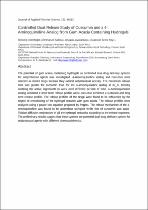 ResearchSpace
ResearchSpace
Controlled dual release study of curcumin and a 4-aminoquinoline analog from gum acacia containing hydrogels
JavaScript is disabled for your browser. Some features of this site may not work without it.
- ResearchSpace
- →
- Research Publications/Outputs
- →
- Journal Articles
- →
- View Item
| dc.contributor.author |
Aderibigbe, BA

|
|
| dc.contributor.author |
Sadiku, ER

|
|
| dc.contributor.author |
Jayaramudu, J

|
|
| dc.contributor.author |
Ray, SS

|
|
| dc.date.accessioned | 2016-05-16T07:19:54Z | |
| dc.date.available | 2016-05-16T07:19:54Z | |
| dc.date.issued | 2014-10 | |
| dc.identifier.citation | Aderibigbe, B.A. Sadiku, E.R. Jayaramudu, J. and Ray, S.S. 2014. Controlled dual release study of curcumin and a 4-aminoquinoline analog from gum acacia containing hydrogels. Journal of Applied Polymer Science, 132, 41613 | en_US |
| dc.identifier.issn | 0021-8995 | |
| dc.identifier.uri | http://onlinelibrary.wiley.com/doi/10.1002/app.41613/abstract | |
| dc.identifier.uri | http://hdl.handle.net/10204/8520 | |
| dc.description | Copyright: 2015 Elsevier. Due to copyright restrictions, the attached PDF file only contains the abstract of the full text item. For access to the full text item, please consult the publisher's website. The definitive version of the work is published in Journal of Applied Polymer Science, 132, 41613 | en_US |
| dc.description.abstract | The potential of gum acacia containing hydrogels as controlled dual-drug delivery systems for antiprotozoal agents was investigated. 4-Aminoquinoline analog and curcumin were selected as model drugs because they exhibit antiprotozoal activity. The maximum release time was greater for curcumin than for the 4-aminoquinoline analog at 37_C, thereby enabling the active ingredients to work over different periods of time. 4-Aminoquinoline analog exhibited a short term release profile while curcumin exhibited a sustained and long term release profile. The release profiles of the drugs were found to be influenced by the degree of crosslinking of the hydrogel network with gum acacia. The release profiles were analyzed using a power law equation proposed by Peppas. The release mechanism of the 4-aminoquinoline was found to be anomalous transport while that of curcumin was quasi-Fickian diffusion mechanism in all the hydrogel networks according to the release exponent. The preliminary results suggest that these systems are potential dual-drug delivery system for antiprotozoal agents with different pharmacokinetics. | en_US |
| dc.language.iso | en | en_US |
| dc.publisher | Wiley | en_US |
| dc.relation.ispartofseries | Workflow;16354 | |
| dc.subject | 4-aminoquinoline | en_US |
| dc.subject | Antimalarial | en_US |
| dc.subject | Curcumin | en_US |
| dc.subject | Gum acacia | en_US |
| dc.subject | Hydrogel | en_US |
| dc.subject | Kinetic release profile | en_US |
| dc.title | Controlled dual release study of curcumin and a 4-aminoquinoline analog from gum acacia containing hydrogels | en_US |
| dc.type | Article | en_US |
| dc.identifier.apacitation | Aderibigbe, B., Sadiku, E., Jayaramudu, J., & Ray, S. (2014). Controlled dual release study of curcumin and a 4-aminoquinoline analog from gum acacia containing hydrogels. http://hdl.handle.net/10204/8520 | en_ZA |
| dc.identifier.chicagocitation | Aderibigbe, BA, ER Sadiku, J Jayaramudu, and SS Ray "Controlled dual release study of curcumin and a 4-aminoquinoline analog from gum acacia containing hydrogels." (2014) http://hdl.handle.net/10204/8520 | en_ZA |
| dc.identifier.vancouvercitation | Aderibigbe B, Sadiku E, Jayaramudu J, Ray S. Controlled dual release study of curcumin and a 4-aminoquinoline analog from gum acacia containing hydrogels. 2014; http://hdl.handle.net/10204/8520. | en_ZA |
| dc.identifier.ris | TY - Article AU - Aderibigbe, BA AU - Sadiku, ER AU - Jayaramudu, J AU - Ray, SS AB - The potential of gum acacia containing hydrogels as controlled dual-drug delivery systems for antiprotozoal agents was investigated. 4-Aminoquinoline analog and curcumin were selected as model drugs because they exhibit antiprotozoal activity. The maximum release time was greater for curcumin than for the 4-aminoquinoline analog at 37_C, thereby enabling the active ingredients to work over different periods of time. 4-Aminoquinoline analog exhibited a short term release profile while curcumin exhibited a sustained and long term release profile. The release profiles of the drugs were found to be influenced by the degree of crosslinking of the hydrogel network with gum acacia. The release profiles were analyzed using a power law equation proposed by Peppas. The release mechanism of the 4-aminoquinoline was found to be anomalous transport while that of curcumin was quasi-Fickian diffusion mechanism in all the hydrogel networks according to the release exponent. The preliminary results suggest that these systems are potential dual-drug delivery system for antiprotozoal agents with different pharmacokinetics. DA - 2014-10 DB - ResearchSpace DP - CSIR KW - 4-aminoquinoline KW - Antimalarial KW - Curcumin KW - Gum acacia KW - Hydrogel KW - Kinetic release profile LK - https://researchspace.csir.co.za PY - 2014 SM - 0021-8995 T1 - Controlled dual release study of curcumin and a 4-aminoquinoline analog from gum acacia containing hydrogels TI - Controlled dual release study of curcumin and a 4-aminoquinoline analog from gum acacia containing hydrogels UR - http://hdl.handle.net/10204/8520 ER - | en_ZA |





